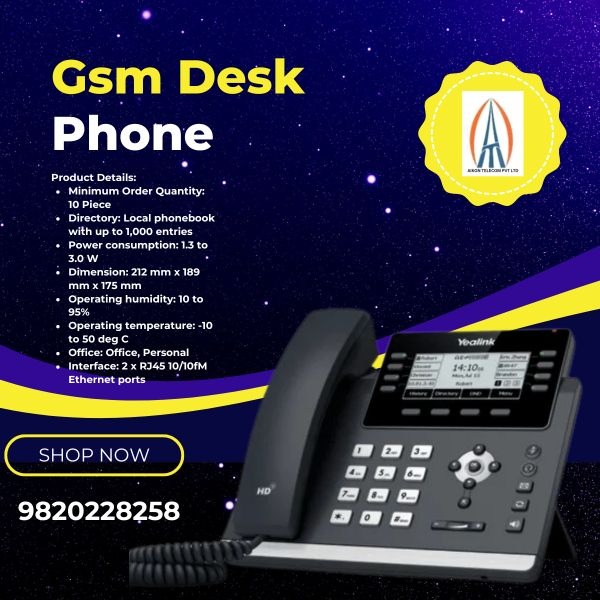
2024-09-07T18:30:27
GSM Desk Phone: The Perfect Blend of Traditional Telephony and Mobile Connectivity In the modern world of communication, businesses and individuals need a versatile solution that combines the reliability of traditional landline phones with the flexibility of mobile connectivity. Enter the GSM Desk Phone—a practical device designed to meet the communication needs of offices, small businesses, and personal users alike. In this blog, we’ll dive into the features, benefits, and applications of the GSM Desk Phone, focusing on a product that comes with a robust set of specifications, including a local phonebook with up to 1, 000 entries, Ethernet ports, and minimal power consumption. What is a GSM Desk Phone? A GSM Desk Phone functions like a traditional office phone but uses a GSM SIM card instead of being connected to a landline. It can make and receive calls using mobile networks, offering an excellent alternative for businesses or personal users who need the reliability of a desk phone without the need for a fixed line connection. Unlike a landline, which is tied to a specific location, a GSM Desk Phone is highly portable, enabling users to place the phone anywhere there is GSM network coverage, even in remote or rural areas where traditional phone lines may not be available. Key Product Features 1. Local Phonebook with Up to 1, 000 Entries The GSM Desk Phone allows users to store up to 1, 000 contacts in the local phonebook. This feature is particularly useful for businesses that need quick access to a large number of client or supplier contacts. By storing numbers directly on the phone, users can streamline their workflow and avoid relying on external devices or directories. 2. Power Consumption: 1.3 to 3.0 W Energy efficiency is a critical factor in today’s world, and this GSM Desk Phone doesn’t disappoint. It operates with a power consumption range of 1.3 to 3.0 W, making it an eco-friendly choice for both offices and personal use. This low power consumption also reduces operating costs, especially for businesses with multiple desk phones in operation. 3. Dimensions: 212 mm x 189 mm x 175 mm The compact design of the GSM Desk Phone, with dimensions of 212 mm x 189 mm x 175 mm, makes it suitable for desk placement in any office or home environment. Its ergonomic build ensures that it doesn’t take up too much space while maintaining all the essential functions of a traditional desk phone. 4. Operating Humidity: 10 to 95% This phone is designed to operate efficiently in a wide range of humidity levels, from 10% to 95%. This feature is particularly useful for industrial or office environments where varying humidity levels are common. 5. Operating Temperature: -10°C to 50°C With an operating temperature range of -10°C to 50°C, this GSM Desk Phone is built to withstand a variety of environmental conditions. Whether you’re in a cold storage facility or a warm office, this device ensures reliable performance. 6. Interface: 2 x RJ45 10/100M Ethernet Ports The device is equipped with two RJ45 Ethernet ports, which offer 10/100M connectivity. These Ethernet ports allow the phone to connect to local networks, which is ideal for businesses that require stable internet connectivity for voice-over-IP (VoIP) services, data management, or connecting to networked devices. 7. Usage: Office and Personal This GSM Desk Phone is highly versatile and can be used in both office and personal settings. Whether it’s for making business calls or staying in touch with friends and family, this phone offers a professional-grade experience in any context. Benefits of Using a GSM Desk Phone 1. Mobile Connectivity with a Traditional Desk Phone Experience One of the main advantages of the GSM Desk Phone is that it provides the familiarity and convenience of a desk phone while leveraging the power of GSM mobile networks. This combination allows users to enjoy the best of both worlds—reliable, stationary communication with the flexibility of mobile service. 2. No Landline Required For users in locations without access to traditional landlines, the GSM Desk Phone offers a viable alternative. Since it operates using a GSM SIM card, it can be used anywhere with mobile network coverage, making it ideal for rural areas, temporary office setups, or locations where landline services are unavailable. 3. Easy to Set Up and Use GSM Desk Phones are simple to set up. All you need to do is insert a SIM card and you’re ready to make and receive calls. There’s no need for complicated installation procedures or wiring, making it a hassle-free communication solution for businesses or individuals. 4. Cost-Effective Communication Since this phone utilizes GSM networks, users can often take advantage of mobile tariff plans, which can be more affordable than traditional landline services. This can be a significant cost-saving measure for businesses or individuals who make frequent long-distance or international calls. 5. Multiple Connectivity Options

Have a question? Ask here!
Required fields are marked *